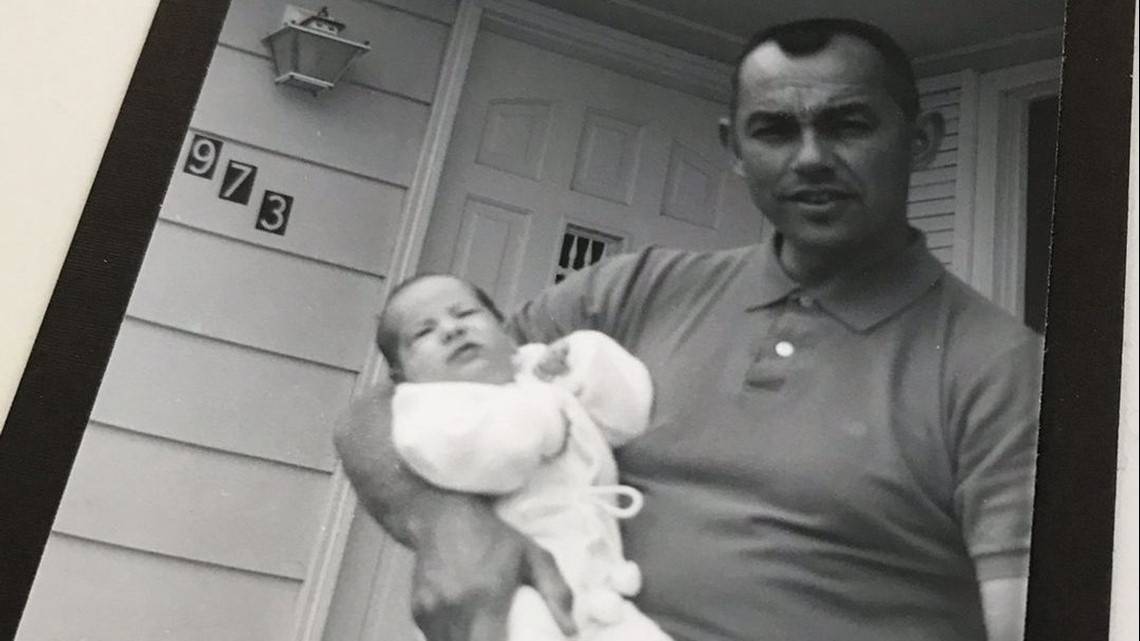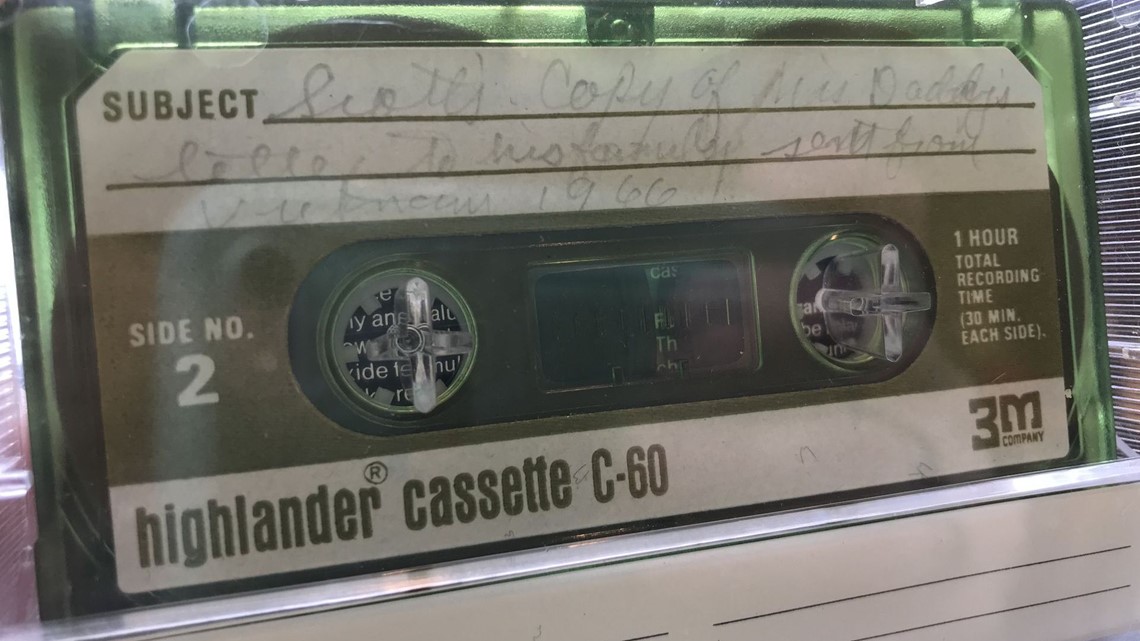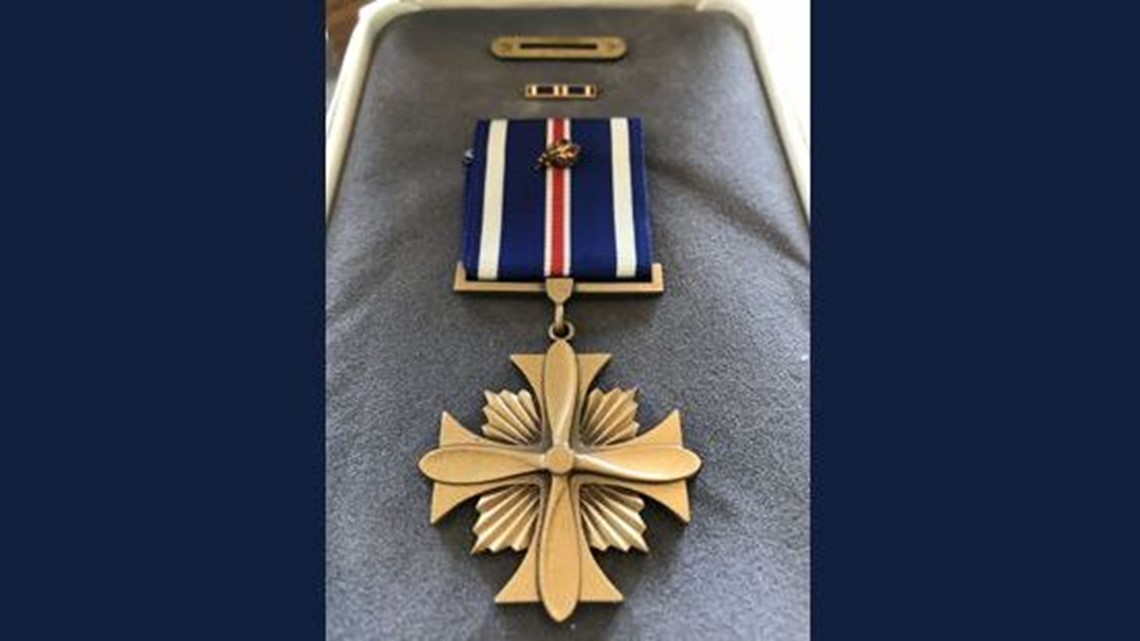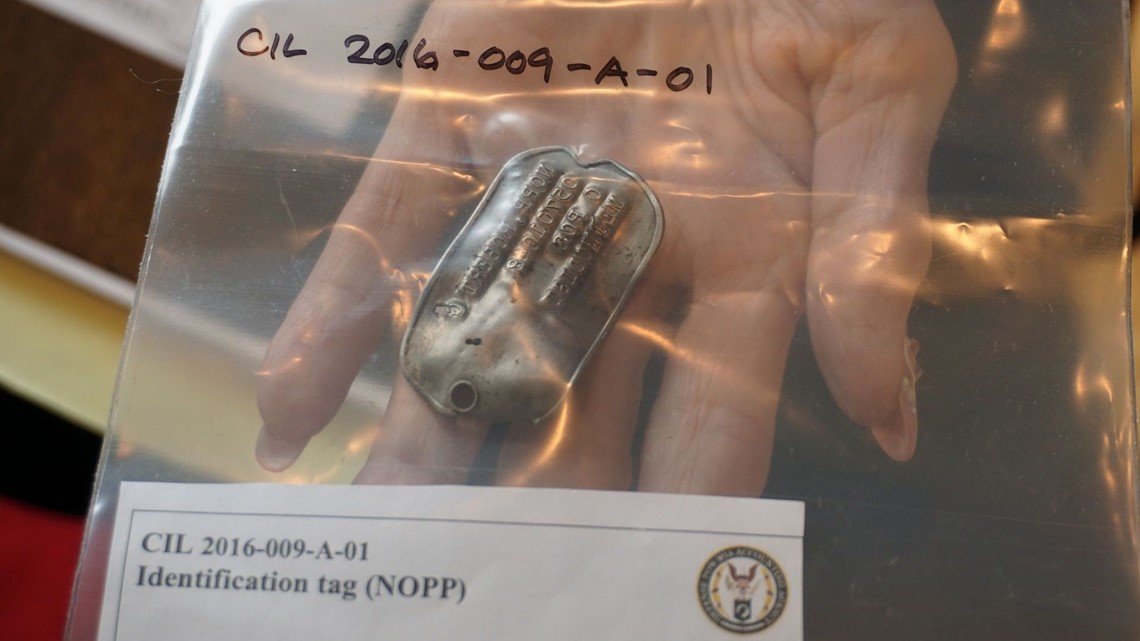Patti Nopp places the cassette player on her lap, inserts the tape and pushes the play button, although she might as well be pressing rewind.
The voice on the recording transports her back in time more than five decades when her husband was serving in the war in Vietnam and she was caring for a 5-year-old and an infant in Salem.
"Happy birthday, honey. You don't know how much I wish I could be there with you today," Bob Nopp says on the tape. "It's awful hard on you, I know, having to take care of the boys and be so far apart, and it's equally hard on me."
For 16 minutes and 7 seconds — his soothing voice projecting over the constant whir of an air conditioner — he reminisces about home, shares observations of daily life with the 131st Aviation Company, and counts the days, weeks and months until R&R and a possible promotion.
"I haven't listened to it in years," Patti says as she wipes away tears.
The first time was in 1966, on her birthday in July, thanks to thoughtful and strategic planning on Bob’s part.
Two days later, Bob was reported missing in action during a classified night surveillance mission.
For the next 52 years, Patti coped with not knowing what happened after the aircraft Bob was piloting vanished over Laos.
The war ended, and prisoners came home. Patti raised her two sons. They held a memorial service in 1979. The boys grew up, moved away and raised families of their own.
And then, two months ago, she received a call from a U.S. Department of Defense agency whose mission is to recover military personnel listed as prisoners of war or missing in action.
The remains of Capt. Robert G. Nopp, promoted posthumously to lieutenant colonel, were recovered at the base of a rock cliff in Laos and identified at a lab in Hawaii.
"I never in my wildest dreams thought I'd ever live long enough to see this," Patti says, sitting in the dining room of her Salem home.
Family roots run deep in Salem
Bob Nopp grew up in Salem, where the Nopp name should be familiar to longtime residents.
His uncles owned and operated Nopp's Golden Pheasant, a popular downtown restaurant on Liberty Street NE. The family sold it in the mid-1990s.
One of the uncles branched off and opened a pawn shop, Nopp's Jewelry & Art, just a few blocks to the north and west. It closed in September 2017.
The uncles' brother was Bob's dad, who worked for Eyerly Aircraft.
Bob was the youngest of three children and the only son. He attended Highland Elementary School and Parrish Junior High, where he was involved in student council and chorus, according to Statesman Journal archives.
Mary Wright, one of his sisters, remembers how much he loved golf, baseball — and ketchup.
"He had ketchup with everything," she says with a laugh.
They were just a year apart and once they both had driver's licenses, the battle for car keys was on.
"We had one old car and one nicer new car, and we would take turns on who got the new car on weekends," Mary recalls. "Bob was so sweet, though. If I said my girlfriends and I were going to go out, he would give in all the time."
Bob graduated from Salem High School in 1952. He attended what was then Oregon State College, where he pledged the Kappa Delta Rho fraternity and was commissioned through the Army ROTC program.
Road to Vietnam through five states
Bob was a page in the House chamber at the Oregon State Capitol while waiting for his military assignment. That's where he met Patti. Her uncle was a state representative from Eugene, where she grew up, and she was his secretary while attending Willamette University.
Patti felt a tap on her shoulder one day and it was Bob, asking how her finals went. Her uncle must have told him why his secretary had been out. Truth be told, she had taken notice of the good-looking page sitting up front in the chamber.
The next time Bob tapped her on the shoulder, it was to ask her out to lunch. After getting approval from her uncle, they had their first date at the Golden Pheasant.
Patti asked Bob if he was aware this was the best restaurant in town. Moments later, a woman working there approached, and Bob introduced them: "Patti, meet my Aunt Opal."
They were married in 1959, and Bob's first duty assignment was at Fort Lewis, Washington. From there, the couple spent time at Army installations in Alabama and Texas, and then Alabama again.
Tim, their oldest son, was born in Alabama.
Bob was a doting father. Once Tim was old enough, he treated his son to guys night out. Patti would pack them a double thermos with coffee on one side and hot chocolate on the other, and they'd usually go to a football game. She wasn't allowed to tag along.
The family had stints in Oklahoma and then Arizona, where Bob was trained in jungle warfare. As his deployment approached, and with Patti seven months pregnant, they returned to Salem.
Scott, their youngest son, was born here in late February 1966. A few weeks later, Bob left for the war.


Letters on tape are heartfelt
The couple corresponded often during his three-plus months in Vietnam. The audio letters on cassette tape were always a treat for Patti, especially the last one.
It starts out by wishing her happy birthday and saying he hopes she likes the presents he sent her. She remembers getting a couple of rings.
He reminds her the selection is limited but says he's looking forward to spending R&R in Hong Kong or Bangkok and shopping for her there.
Bob tells her he flies 20-25 missions a month, most of them 2½ hours in duration. Since he’s taken over the infrared section of the company, he has access to an air-conditioned area where equipment is stored. He records his audio letters there.
He talks briefly about a couple of minor mishaps that have happened with his unit's aircraft equipment, then cautions her to not think the worst.
"I don't want you to think that all our flights are real bad," he says.


He gives a run-down of what he’s been doing during his free time, including watching movies at a drive-in theater and baseball and "Gunsmoke" on television.
He mentions his mom, his sisters and his best friend Bob Foreman — they grew up together in Salem — and sends a direct message to his son Tim.
"Timmy, your daddy misses you an awful lot, all the good times we used to have playing ball and wrestling and stuff," he says on the tape. "I wish more than anything I could be there with you, to play with you and take you swimming."
Bob reminds the boy to be good and mind his Mama. He also says he's proud to hear he's been a big help with his baby brother.
Turning his attention back to Patti, Bob says he's glad to hear the Oldsmobile is running well and not causing her any problems and pleased to find out she's taken an interest in golf.
He thanks her for sending him newspaper clippings about local golf tournaments and says if she hasn't seen the "Army Times" yet, he made the list for promotion.
The last tape was recorded and shipped long before Nopp's final mission.
Life goes on for family
The Army was good to Patti. Once a month, for 13 years after Bob was declared MIA, a casualty assistance officer would come to her home.
The officer might change but never the offers. Can we do anything for you? Is there anything you need?
Once she asked for help moving.
Patti clung to hopes her husband would be found, but she went on with her social and personal life. As time passed, a part of her hoped he died in the crash rather than be held prisoner and tortured all those years.
The family held a memorial in November 1979 at McNary Golf Course, an appropriate venue. Bob once entertained an offer to become a teaching pro rather than continue his military career, and McNary was the last place he teed off.
"There was still never closure," says Bob Foreman, a frequent golf partner and one of his best friends. They both grew up on 4th Street NE, about three blocks apart.
Foreman delivered the eulogy, and a four-man formation of Mohawks, minus one aircraft, did a fly-over. The lead aircraft was piloted by a man who helped with the initial search for Nopp after his plane went missing.
Weather, terrain factor in crash
Incident reports indicate there were moderate thunderstorms with heavy rain and poor visibility during the night of July 13, 1966, when Nopp was sent on a classified surveillance mission over Laos on the western border of Vietnam.
He departed the base near Phu Bai at 11 p.m. in a Grumman OV-1C Mohawk, a tactical reconnaissance and battlefield observation aircraft with twin turboprops.
The two-seater was equipped with side-looking radar that could record and develop images in flight and an infrared sensor system in its belly that could spot evidence of ground enemy activities at night, in poor weather, and under a jungle canopy.
Nopp and his observer lost radar and radio contact 14 minutes after takeoff, which was not uncommon because of mountainous terrain in the target area.
When they failed to return at their scheduled time, an extensive aerial search produced no evidence of the aircraft or its crew. They seemed to have disappeared.
To this day, no one knows what really happened. Was the aircraft brought down by hostile ground fire? Did it encounter severe turbulence from the thunderstorms? Was there some sort of mechanical failure?
The area was known to be heavily defended, and the terrain was challenging for any pilot. Nopp was experienced. He even spent time as an instructor, helping train fellow soldiers on their way to the war zone.


A month before the crash, he was awarded the Distinguished Flying Cross for heroism above and beyond the call of duty while participating in aerial flight. He located several camouflaged enemy positions and despite being under heavy fire, made seven passes and silenced the gun placements.
Patti shakes her head as she reads the citation: "I just look at that and think, 'My God, he was so brave.' "
The medal has a bronze oak leaf cluster on the ribbon, which means he was awarded a second Distinguished Flying Cross. Nopp, 31, also earned a Bronze Star.
Military documents on his last mission were provided to the family during an April 29 meeting in Salem. About 25 family members attended, including Bob's two sisters, who provided DNA samples years ago in hopes that this day would come.
"I tried to include the whole family," Patti says. "They've waited as long as I have."
'It's a miracle they found anything'
It wasn't until the 1990s that the crash site was identified. Referred to as REFNO 0393, it is remote and difficult to access. Located in the southern-most tip of Laos, it's about a 10-minute helicopter ride from the nearest village and at the base of a rock cliff.
It was surveyed twice by joint teams from the U.S. and Laos before being recommended for excavation. Small fragments of aircraft wreckage were recovered from the site in 1995, including ejection seat items, and determined to be from a Mohawk.
Excavations were done twice, from October through December 2015 and again from January through February 2016.
The recovery leader, an anthropologist, reported excavation was slow and most effective using small hand tools because of the terrain. The site features an abundance of rocks and boulders, from handheld to house-sized, creating many cavities and crevices to search.
"It's a miracle they found anything," says Tim Nopp, who lives in Palm Desert, California.
Teams recovered possible human remains, life support equipment, and other evidentiary material.
The human remains were sent to the Defense POW/MIA Accounting Agency laboratory in Honolulu, Hawaii, the largest and most diverse skeletal identification lab in the world staffed by more than 30 anthropologists, archaeologists, and forensic dentists.
Samples from three long bone fragments and a cranium bone fragment were examined and compared to DNA samples submitted by Bob's sisters, who live in Salem. The remains of Pfc. Marshall F. Kipina, who shared the cockpit with Nopp on that fateful mission, also were recovered and identified.
Almost as important to the Nopp family was the recovery of Bob's dog tag, his military ID. It was returned to Patti in a plastic bag sealed with red "EVIDENCE" tape.


The dog tag is crumpled and corroded, but the stamped writing remains legible. In serif typeface, it has Nopp's name, serial number, blood type (O positive), and religious preference (Methodist).
Patti hasn't opened the bag and may never. It's the most precious item she has that belonged to Bob. That and the cassette tape.
Her husband will be buried in October at Arlington National Cemetery.
“Forward This” highlights the people, places, and organizations of the Mid-Willamette Valley. Contact Capi Lynn at clynn@StatesmanJournal.com or 503-399-6710, or follow her the rest of the week on Twitter @CapiLynn and Facebook @CapiLynnSJ.

